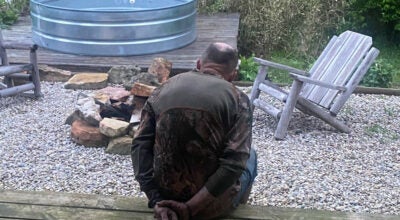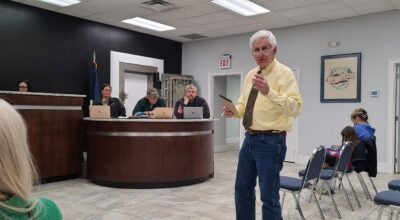Boyle jail population bottoms out at 229 in July
Published 6:00 am Wednesday, August 8, 2018

- Public domain
Last August, the Boyle County Detention Center was packed. It peaked at 412 inmates one day — 187 percent of its rated capacity — and averaged 392 per day in the month, according to an average monthly population report.
But since that time, it’s been largely downhill, as the population saw fairly steady declines over the next 12 months. In July, the jail had an average daily population of 285, the lowest since last August, according to the report. Jailer Barry Harmon said at one point in the month, there were only 229 inmates in the jail, only nine more than the jail’s 220-bed capacity.
“I walked out on the floor one day in July, and I stood there by the control room and I listened,” Harmon said. “And I listened. And I couldn’t hear anything. Before, you could hear people in the dorms, hear them talking and stuff. It was a lot more noise, so it’s a lot quieter now.”
Harmon said the lower number of inmates has “made a huge difference” in many different ways. There are fewer inmate-on-inmate incidents. The jail is saving on water, sewer and electricity. Food and laundry costs are down, as well.
Harmon said the transformation is thanks to work being done by Boyle County Attorney Lynne Dean, Mercer County Attorney Ted Dean and District Judge Jeff Dotson. The attorneys and judge look every week for people who they can release from the jail, he said.
“People that really don’t need to be in jail, that really aren’t a threat,” like people with non-violent misdemeanor charges — “they’re putting them out instead of keeping them in jail,” Harmon said.
Last week, the jail population was in the 230s on multiple days. On Monday, it was in the 250s; at 2 p.m. on Tuesday, it was at 260.
Lynne Dean said the changes at the jail are due to efforts from many different individuals and groups, including law enforcement officers, the public defender’s office and community efforts outside of jail to help people with addiction problems.
“All those resources pulling together” have allowed the jail population to decrease slowly over time without harming public safety, she said.
Dean said one thing she has been doing is communicating with law enforcement officers about drug-related cases, trying to get the officers’ perspectives on whether someone is a significant drug dealer who needs to be in jail, or if they’re perhaps a user who sells some drugs to support the habit and they could benefit from going to rehab instead of sitting in jail.
Such conversations have been happening for a long time, but they’ve gotten more productive recently, Dean said.
“I think our law enforcement officers have grown in that regard and they have more confidence that we’re listening to them and taking their opinions or thoughts into consideration,” she said. “I think they’re seeing that some people — you’ve got to let them out. I know I have seen people successfully complete recovery. I think they’re seeing that as well. So that’s encouraging to everyone. And that lets them know this rehab thing is not just something people are talking about; I can see it with my own eyes.”
The local public defender’s office has a social worker on payroll who helps defendants determine what their health insurance covers or if they’re eligible for Medicaid, Dean said. They have developed a large network of rehab facilities they can refer people to if they need help with a substance-use disorder.
“We have been sending people pretty frequently to different rehabs,” she said. “And because they keep the court informed, Judge Dotson is comfortable with that.”
Boyle County’s “Rocket Docket” program, which fast-tracks cases so people get sentenced and taken off the county’s dime quicker, has also been helpful over time in bringing down the jail population, she said.
The Shepherd’s House treatment program, which allows some inmates to leave jail while they work on job training, drug counseling and more, is another program leading to lower jail numbers, Dean said. So are the numerous rehabilitation and addiction support groups that have cropped up in recent years. And the use of diversion for people charged with first-time marijuana possession, she added.
Dean said elimination of the private probation-monitoring agency Kentucky Alternatives Program has also contributed. It “has cut down on the number of people coming back on probation violations,” she said.
The district court for Boyle and Mercer counties, overseen by Judge Dotson, ended its use of KAP in February 2017, citing a recent rule change by the Kentucky Supreme Court.
Dean said now, defendants are probated to the court, meaning the court system is responsible for monitoring their compliance with the terms of their release.
“Frankly, none of us have the time to monitor those as closely as KAP did,” Dean said, adding that she is comfortable with the level of monitoring the court can provide. “… I still think we’re all focusing on that community safety perspective. I feel like the community is still safe. We may not be catching every little thing. And KAP caught every little thing.”
Dean said she, the Mercer County attorney and Judge Dotson are “constantly talking about jail population — what we’re doing, how we can do a better job.”
“We’re truly, truly fortunate to have Judge Dotson,” she said. “… He is open to any suggestions that I have. He may have suggestions himself. We try to share information and communicate regularly.”
Dean said the focus is always on public safety first.
“I think that’s at the forefront of everybody’s mind. I think there’s this cloud over all of us at all times when we’re making a decision — what if something bad happens?” she said. “… If you’re truly thinking about public safety and the community’s safety — for me, I try to let that really be my guide.”
Dean noted some law enforcement officers have told her they believe it’s also “just a calmer year” without as many severe incidents leading to arrests. She said she’s not sure if the jail population could be driven any lower, and worries at times it’s an anomaly that it’s as low as it is.
“I go back and forth. Sometimes I feel like, ‘this is good; it’s going to get lower.’ And sometimes I think that we could build a huge jail with however many beds and it would just fill up. It just ebbs and flows. I don’t know what the answer is.”






